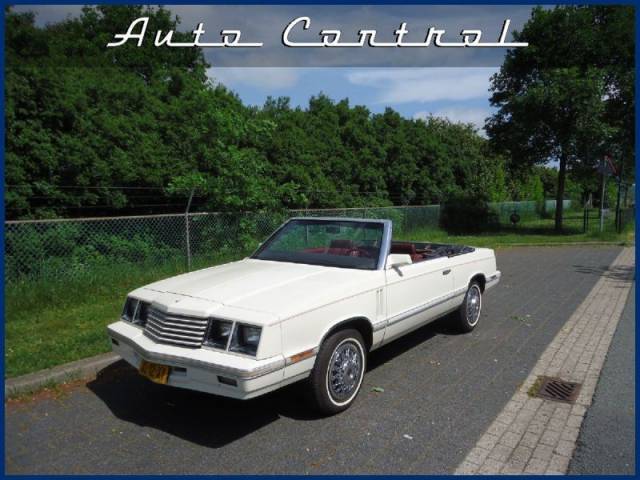Dodge 400 Classic Cars for Sale
The Dodge 400 occupies a distinct niche in automotive history as a mid-size American car introduced for just two years, 1982 and 1983. It represents a unique snapshot of 1980s automotive design and technology, offering a rare sight on today’s roads due to its brief production run.
Search results
Currently, there are no matching listings for your search.
Create search alert
Let yourself be notified as soon as a listing is published that matches your search filters.
Create listing
Do you have a Dodge 400 that you want to sell? Then create a listing now.
Create listingDodge 400 listing references from Classic Trader
Below you will find listings related to your search that are no longer available on Classic Trader. Use this information to gain insight into availability, value trends, and current pricing for a "Dodge 400" to make a more informed purchasing decision.

1982 | Dodge 400
1983 | Dodge 400
Weißes Cabriolet, US Import, in gutem Zustand, Ideal für den Sommer
Create search alert
Let yourself be notified as soon as a listing is published that matches your search filters.
Create listing
Do you have a Dodge 400 that you want to sell? Then create a listing now.
Create listingHistory of the Dodge 400
Launched at the beginning of the 1980s, the Dodge 400 was Dodge’s mid-size entry that attempted to provide a refined alternative to the more utilitarian Dodge Aries. Developed on the Chrysler Super K platform, also shared with the Chrysler LeBaron, the 400 was positioned as an upmarket, more comfortable family car. Its sharp-edged bonnet and characteristic American lines reflected design trends of its era. Unfortunately, its time in production was short: after underwhelming market performance in just two years, Dodge merged the 400 into the better-received Dodge 600 range. Despite unfulfilled commercial ambitions, the 400 stands as a testament to the evolving American car landscape, linking the Malaise era with the more modern cars that followed.
Model History
The Dodge 400 succeeded the revered Dodge Challenger, although the two had little in common in terms of concept or engineering. The 400 replaced the two-door sports coupe with a range – coupe, convertible, and sedan – catering to broader needs. Its technical and design traits derived from Chrysler K-cars, though offered with improved materials and additional equipment. Production ran from 1982 to 1983 only, and after poor sales, it was integrated into the new Dodge 600 lineup. Its short lifecycle and low production numbers contribute to its rarity today.
Highlights of the Dodge 400
The Dodge 400 stood out for its three body styles—coupe, convertible, and sedan—making it versatile within the mid-size segment. The car debuted with two engine options: a 2.2-litre four-cylinder and a 2.6-litre four-cylinder engine, both mated to a three-speed automatic transmission as standard. Minimal changes defined the only variant, the LS, which received mainly cosmetic updates.
According to market statistics, the Dodge 400 accounts for 100% of Dodge listings and views in this series on Classic Trader, indicating its unique position and singular offering in this segment.
Technical Data
Special Editions and Collectible Models
The Dodge 400 LS represented the only proper variant in the series, distinguished primarily by a polished trim at the car’s base. No significant mechanical or performance improvements set the LS apart, making it a visual upgrade rather than a substantial special edition. As a result, LS models are rare but not technically distinct from standard 400s.
Engine, Transmission and Handling
The Dodge 400 offered modest performance, with its four-cylinder engines delivering an experience typical of American mid-size cars in the early 1980s: smooth, but not sporty. The standard three-speed automatic gearbox gave the car a relaxed driving feel, best suited for comfortable urban and suburban cruising. The ride character reflects period expectations, prioritising comfort over dynamic handling. Typical 1980s American suspension settings ensured soft chassis behaviour and moderate cornering grip. Notable is the LS variant, though it is largely similar technically to the base models. No performance-specific special editions were produced.
Interior, Comfort, Exterior and Design
Externally, the Dodge 400 featured straight, angular lines with a sharp, arrow-shaped bonnet. The LS variant introduced polished trim for a slightly more upscale appearance. Interiors were designed with materials and seating emphasising comfort for American buyers of the era, though not reaching the plush standards of the luxury class. Dealer and catalogue accessories in period included power windows, air conditioning, and upgraded audio, desirable by today’s collector for authenticity. The convertible body style is particularly notable, as drop-top mid-size Americans from this period are unusual.
Other Features
The Dodge 400’s direct comparison to the Chrysler LeBaron of the era points to shared platform characteristics and interchangeable parts. Such interchangeability can simplify sourcing essentials for restoration, an advantage for today’s owners. Due to its short production span and low sales figures, surviving Dodge 400s have become relatively rare in both coupe and especially convertible forms.
Summary
The Dodge 400 is a rare mid-size American classic from the early 1980s. Offered as a coupe, sedan, and convertible, and available with two four-cylinder engines, it serves as a unique bridge between the utilitarian K-cars and Dodge’s later front-wheel-drive sedans. The short production run and singular LS variant make every 400 a distinctive find on the classic car market. Its period styling, versatility, and ties to American automotive history offer an experience that is distinctly 1980s Dodge.
